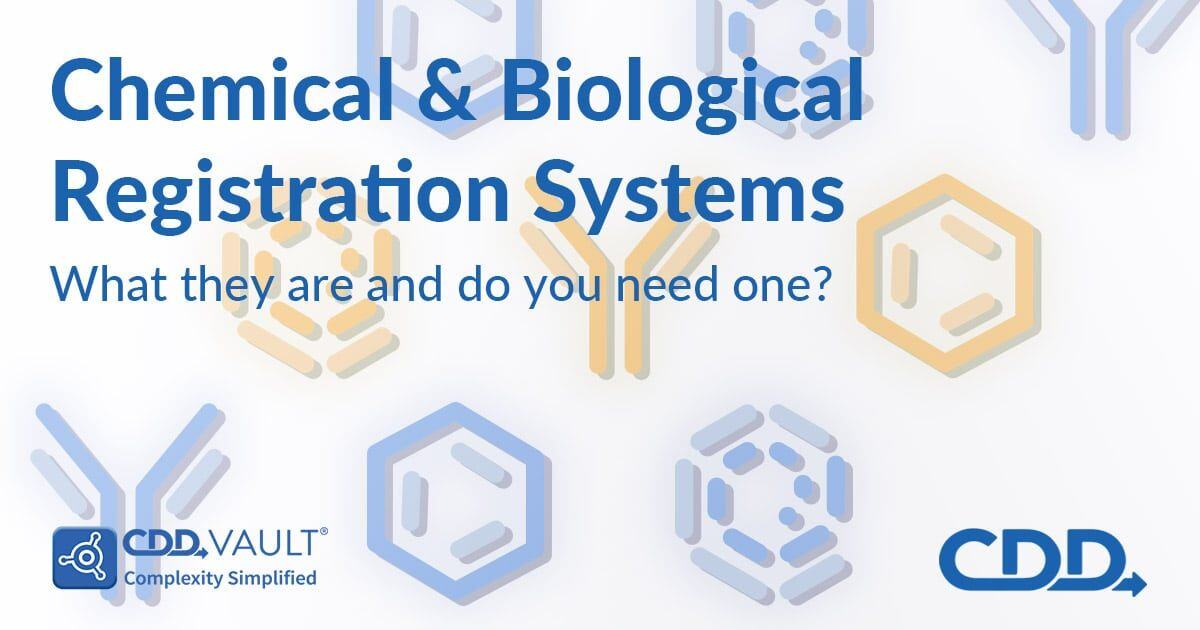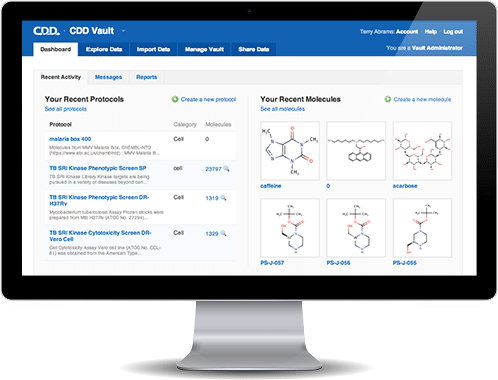
Author: Barry Bunin, PhD
What are Registration Systems?
Chemical and Biological Registration systems can be useful IT tools in the arsenal of labs that are looking to streamline their workflows. As the name implies, registration systems are designed to help track the different chemical or biological entities used for experiments, as well as new ones created in the lab as intellectual property. A core function of registration systems is the ability to generate (or mirror) unique identifiers that unambiguously identifies each entity and batch combination. Among other functionality, these systems support the ability to capture information on complex chemical and biological molecules including details about their structure, various physical and chemical properties, and assay testing data.
Benefits of Registration Systems
- Findability - Perhaps the most important reason for registering entities is also the most obvious one, findability. Being able to find what's needed for a given test at any point saves time, and results in less frustration for researchers. Labs can have hundreds or thousands of molecules and/or biologicals in stock at any given time. These include reagents, as well as entities made for testing as the core part of an organization's intellectual property portfolio.
- Uniqueness - A related and equally important consideration, for labs that work with chemical compounds or biologicals, is being able to track Important details about an entity (lots, salts, etc) that are related to uniqueness and a cause for ambiguity or duplication errors. Registration systems can flag when researchers are unwittingly duplicating entries or screening different forms of the same entity. These systems can also distinguish between entities that have similar structures, sub-structures, or sequences.
- Tracking - Another reason to register your entities using a registration system is their ability to store chemical and biological entities for future tracking. Researchers can run queries for entities and see full details about the structures including information on stereochemistry or similar sequences.
- Compliance - Lastly, labs need to comply with various state and federal regulations and a good registration system can help ensure that there are no surprises during lab inspections or audits. Since the information is present in a single, centralized location, reports can be created quickly - accounting for all present entities.
How do Chemical and Biological Registration Systems Compare?
Broadly, entities that can be registered fall into two categories: 1. chemical molecules and 2. biological entities. Some registration systems specialize in handling one category, while others are designed to accommodate both.
Chemical Registration: include tools for entering individual compounds and groups of compounds, searching for compounds by structure, and for assigning unique identifiers for each compound that comes into the lab. These systems include functionality for establishing and showing relationships between individual compounds and families of compounds, and for linking compounds to associated screening data in the lab. Moreover, chemical systems are a step up from some chemical databases which simply store the molecule without some of the more fine-grained details about stereochemistry or associated screening data.
Biological Registration: offer functionality that lets users define, register, query, and report on biological entities including proteins, enzymes, antibodies, DNA, RNA, cell lines, plasmids, proteins, siRNAs, and protein-drug conjugates. It also includes tools for managing relationships between biological entities, collecting details on individual entities such as protein expression information, and generating chemical representations of entities where possible.
Features of Registration Systems
General benefits of registration systems include the following:
- Managing and tracking individual chemical and biological entities as well as mixtures of compounds efficiently and automatically
- Quick and easy queries to locate entities of interest
- Assigning unique identifiers to biomolecules and compounds
- Reduction in the amount of time spent searching for compounds as well as time and resources wasted on testing unknown forms of the same compound
- Information on different entities used in lab experiments can be accessible from a single system
- Combined functionality for drawing and naming structures, adding and visualizing annotations, and editing structures in a single system
- Most vendors can seamlessly integrate their registration systems with existing lab infrastructure and software
- Ability to create audit trails and reports
Specific benefits of Chemical Registration Systems include:
- Ability to register single compounds or batches of compounds using Structure Data files or SMILES strings
- Flags duplicate entries as errors
- Ability to capture information about predicted chemical properties based on the compound structure
- Registering relationships between related compounds and salts or isotopes of the same compound
- Searching for compounds by structure, sub-structures, and alternative structures
- Registering and storing multi-component compounds
Specific benefits that Biological Registration Systems include:
- Ability to register single biological entities or batches of entities
- Collecting details on various biologic samples
- Tools for creating and sharing complex biomolecules
- Tools for performing sequence similarity searches
- Tools to create relationships between different molecular entities to establish lineage and track genealogy
- Functionality for calculating biological properties
Commercial Registration Systems
There is a broad range of commercial solutions on the market offering entity registration functionality. As with many commercial solutions, vendors may include additional, bespoke functionality and features in their systems. In most cases, these systems can be easily integrated with existing lab infrastructure including inventory software such as Electronic Laboratory Notebooks and Laboratory Information Management Systems, and some may even offer APIs that can automate certain data management workflows, achieving even greater time-saving.
Available solutions in the market include:

Why are Registration Systems Better than Spreadsheets?
Spreadsheets have their uses. And they may seem like a viable option for tracking your labs' entities. But they are limited and as the list of compounds and/or biologicals grows, spreadsheets become less effective. Furthermore, spreadsheets were not created with chemists or biologists in mind. As such they do not have the capacity to properly draw and display chemical structures nor sequences.
It also means that researchers may need to use separate solutions to handle their research entities. For example, they might use a spreadsheet for the names of chemical compounds, and then a separate drawing tool to create the structures. It is a workable solution, however it increases the risk of errors and wastes precious time. Moreover, within Excel, these structures are saved as static images that offer little to no interactivity. Lastly, while it may be possible to program Excel functions that perform various chemistry-related calculations, this takes work and requires a level of expertise that may be beyond most labs' capacity.
Comparing Chemical and Biologial Registration Systems to LIMS & ELNs
LIMS and ELNs are sample registration and tracking systems. Given the purpose for which they were designed, they offer some similar benefits and features that chemical and biological registrations systems do, albeit primarily at the sample level.
The range of functionality that LIMS and ELNs offer may include unique identifiers for samples, chain of custody, custom reporting functionality, role assignment, task management, electronic signatures, supply management, instrument maintenance, customer invoicing and billing, and much more. These systems also offer similar benefits including:
- Easy and automated administration that takes the guesswork out of sample administration and management and cuts down or eliminates paperwork.
- Time and cost savings as a result of more efficient, automated lab processes and workflows can result in significant time and cost savings across the board.
- Information accessible from a single system.
- LIMS and ELN solutions integrated with existing lab infrastructure including sequencing instruments, spectrometers, and PCR machines.
The difference comes down to their specificity. As mentioned at the start of this article "A core function of registration systems is the ability to generate (or mirror) unique identifiers that unambiguously identify each entity and batch combination." Registration systems are built to handle not just the entities themselves but also their structures, sequences and generation of unique registration numbers, and to link these entities to any associated screening data. LIMS and ELNS, unless they are integrated with a registration system, don't generally include this kind of functionality.
How to decide on a Registration System?
The decision to invest in a registration system is one that each lab needs to make individually. If your lab works with large quantities of diverse compounds and/or biological molecules, or works with mixtures of compounds, then an out-of-the-box (ideally web-accessible) system is often a worthwhile investment in your research informatics portfolio. It is important to note here that some labs may have the expertise to build their own systems or use an existing open-source option. However, these options come with some drawbacks including sole responsibility for programming the system, maintenance (often the majority of the overhead over time), ensuring regulatory compliance, software updates and patches, and implementing adequate security.
For labs that are considering purchasing a system, here are a few things to think about:
- Do you have the budget to purchase a system and cover associated costs - installation, licenses, staff training, data storage costs, and any ongoing maintenance? Some commercial software installations can take a significant chunk out of a lab's budget, so it is important to do the math to ensure a solid benefit:cost ratio (ROI).
- Can the registration system integrate with existing lab infrastructure? These days most vendors can offer integration but it is still wise to check that the system you are purchasing will work with third-party infrastructure you have or figure out what it will take to make that happen (either manually, semi-automated, or automated).
- What custom capabilities, enhancements, or upgrades does the vendor offer? Since registration systems offer the same base functionality, bespoke features can make the difference.
- Are there opportunities to engage directly with vendors? It may be helpful to test the software system to find the right mix of design and functionality for your lab. Is the evaluation free vs paid?
- How long will the implementation take? Implementing any software takes time and the same is true for registration systems. As you upgrade from legacy infrastructure, it is important to set expectations and have a plan in place to ensure minimum disruption to lab processes. Is it quick and easy to get set-up or cumbersome?
Conclusion
Being able to quickly glean insights from data and improve productivity is both important and achievable with the right technology solutions. Across industries, Chemical and Biological Registration Systems add significant value to labs working with large numbers of chemical and biological entities and associated data. As part of a larger suite of research informatics tools, these solutions improve operational efficiency, reduce the risks of human error, save time, and ensure the integrity and legacy of your work.
For a powerful data management system with fully integrated compound registration, inventory, ELN, and data visualization, check out CDD Vault.
References
- What is Chemical Registration? https://info.collaborativedrug.com/chemicalregistration
- Chemical Database https://en.wikipedia.org/wiki/Chemical_database#List_of_Chemical_Registration_Systems
- CDD Vault Activity & Registration Module https://www.collaborativedrug.com/benefits/activity-registration/
- Biovia Biological Registration Datasheet https://www.3dsbiovia.com/products/datasheets/biological-registration.pdf
- Chemical Registration Systems http://openbabel.org/docs/current/Cheminf101/registration.html
- The Advantages of a Good Chemical Inventory System https://www.bioraft.com/resources/the-advantages-of-a-good-chemical-inventory-system
- Compound Registration http://www.corelims.com/v4Docs/Chemistry_Specific/Single_Compound_Registration/Chemistry_v4.htm
- Martin, E., Monge, A., Duret, J. A., Gualandi, F., Peitsch, M. C., & Pospisil, P. (2012). Building an R&D chemical registration system. Journal of cheminformatics, 4(1), 11. https://doi.org/10.1186/1758-2946-4-11
This blog is authored by members of the CDD Vault community. CDD Vault is a hosted drug discovery informatics platform that securely manages both private and external biological and chemical data. It provides core functionality including chemical registration, structure activity relationship, chemical inventory, and electronic lab notebook capabilities.




